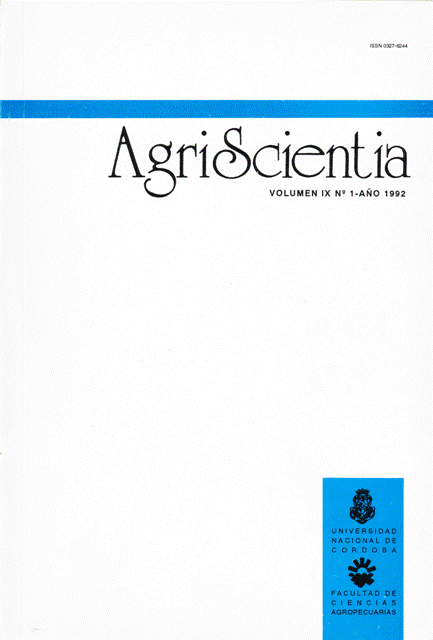Contribution of in vitro flowering to the knowledge of reproductive development in higher plants
Main Article Content
Abstract
In vitro flowering studies can contribute to the understanding of some of the mechanisms involved in reproductive development, in particular those related to vernalization and photoperiodism. However, on account of the excision of plant parts, in vitro studies imply the rupture of correlation phenomena, which can influence the expression of flowering. The following general conclusions can be drawn from the analysis of the in vitro behavior of short and long day plants, either with or without vernalization requirements, and of some photoperiodically indifferent plants: a) Photoperiod and vernalization requirements of explants are identical to those of plants in vivo; b) In some cases, flowering in vitro can be achieved under non-inductive photoperiods; c) Buds developed in vitro are capable of sensing the floral stimuli; d) There is frequent loss of floral induction in vitro; e) Auxins inhibit flowering in vitro.
Article Details

This work is licensed under a Creative Commons Attribution-ShareAlike 4.0 International License.
How to Cite
References
Aghion, D. (1962). C. R. Acad. Sc. Paris, 255, 993-995.
Aghion-Prat, D. (1965). Thèse. Physiol. vég., 3, 229-303.
Baldev, B. (1962). Ann. Bot., 26, 173-180.
Blake, J. (1966). Nature, 211, 990-991.
Borthwick, H. A., & Parker, M. W. (1940). Bot. Gaz., 101, 806-816.
Caplin, S. M., & Siegel, W. O. (1967). Amer. J. Bot., 54, 596-600.
Chailakhyan, M., & Butenko, R. (1959). Dokl. Akad. Nauk SSSR, 129, 224-228.
Chouard, P., & Aghion, D. (1961). C. R. Acad. Sc. Paris, 252, 3864-3866.
De Fossard, R. A. (1966). Austral. J. Sci., 29, 427-428.
Deltour, R. (1967). C. R. Acad. Sc. Paris, 265, Série D, 1932-1935.
El-Nil, M. M. A. (1977). Plant Sc. Letters, 9, 259-264.
Etoh, T., & Ogura, H. (1977). Mem. Fac. Agric. Kagoshima Univ., 13, 77-88.
Harada, H. (1967). Nature, 214, 1027-1028.
Hartman, T. A. (1956). Proc. Kon. Ned. Akad. Wet., 59, 677-684.
Herickson, C. E. (1954). Plant Physiol., 29, 536-538.
Jacobs, W. P., Raghavan, V., & Kaushik, M. P. (1965). Proc. Intrn. Conf. Plant Tissue Culture, 225. Berkeley, California.
Kothari, I. L., & Shah, J. J. (1974). Phytomorphology, 24, 42-48.
Koul, A. K., & Gohil, N. R. (1970). Cytologia, 35, 197-202.
Lang, A. (1952). Ann. Rev. Plant Physiol., 3, 265-306.
Lona, F. (1956). L'Ateneo Parmense, 27, 867-875.
Loo, S. W. (1946). Amer. J. Bot., 33, 382-388.
Margara, J. (1964). C. R. Acad. Sc. Paris, 259, 4787-4790.
Margara, J. (1965). C. R. Acad. Sc. Paris, 260, 278-281.
Margara, J. (1974). C. R. Acad. Sc. Paris, 278, Série D, 1195-1198.
Margara, J. (1988). Multiplicación vegetativa y cultivo in vitro. Ed. Mundi-Prensa. Madrid.
Martinez, E. A., Riquelme, C., & Tizio, R. (1989). C. R. Soc. Biol., 183, 203-207.
Nitsch, J. P., & Nitsch, C. (1964). Bull. Soc. Bot. France, 111, 299-304.
Nitsch, C., & Nitsch, J. P. (1967). Planta, 72, 371-384.
Paulet, P. (1965). Thèse. Rev. Gén. Bot., 859, 697-788.
Paulet, P., & Nitsch, J. P. (1964). C. R. Acad. Sc. Paris, 258, 5952-5955.
Picard, C. (1968). Aspects et mécanismes de la vernalisation. Masson et Cie. Paris.
Pierik, R. L. M. (1966). Naturwiss., 53, 11-2; 53, 45.
Pierik, R. L. M. (1990). Cultivos de tejidos en plantas superiores. Ed. Mundi-Prensa.
Raghavan, V. (1961). Amer. J. Bot., 48, 870-876.
Raghavan, V., & Jacobs, W. P. (1961). Amer. J. Bot., 48, 751-760.
Schwabe, W. W. (1950). J. Exp. Bot., 1, 329-343.
Silvori, E., & Went, F. W. (1944). Bot. Gaz., 105, 321-329.
Tizio, R. (1979). C. R. Acad. Sc. Paris, 289, Série D, 401-404.





